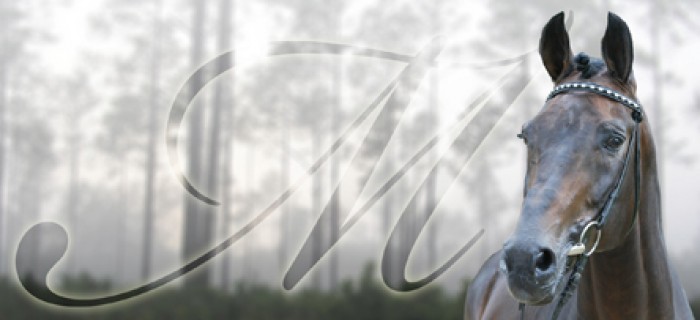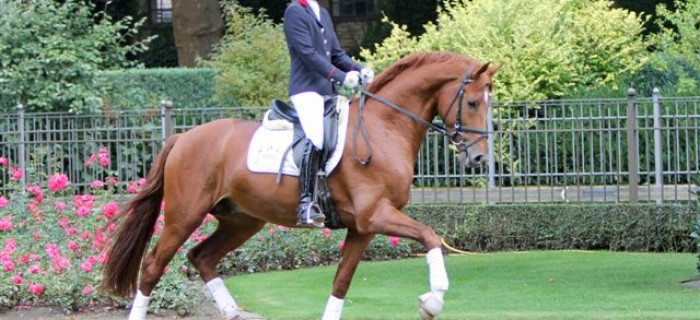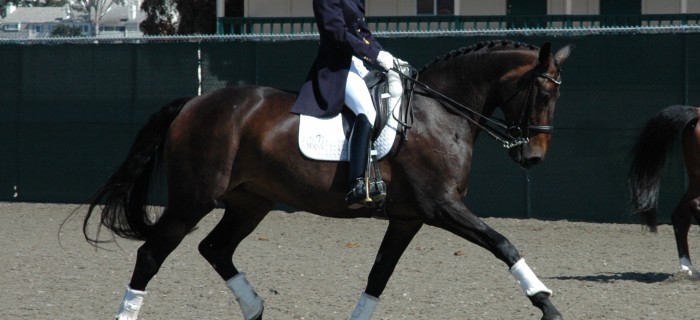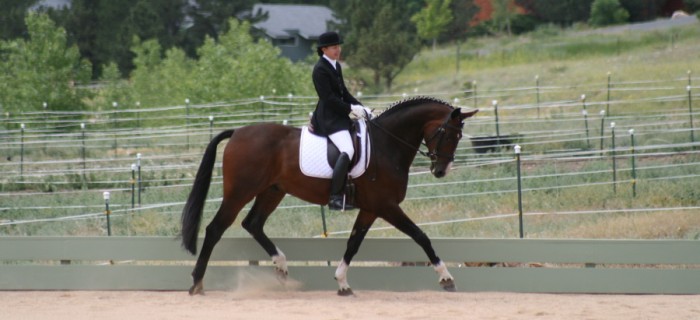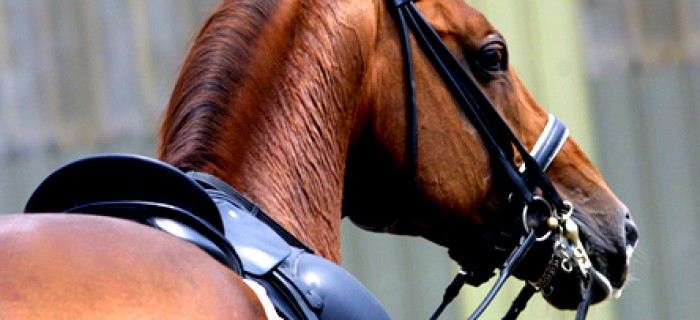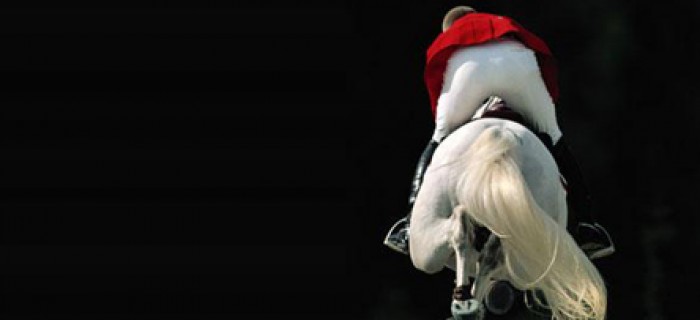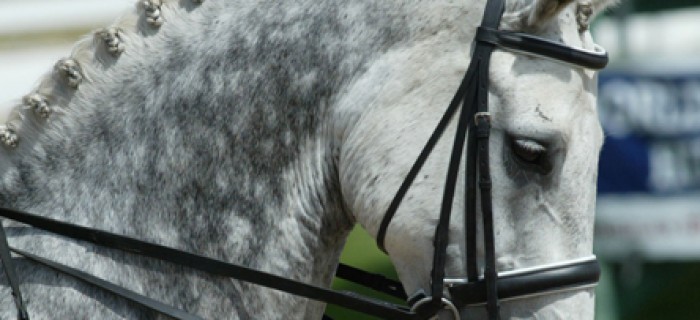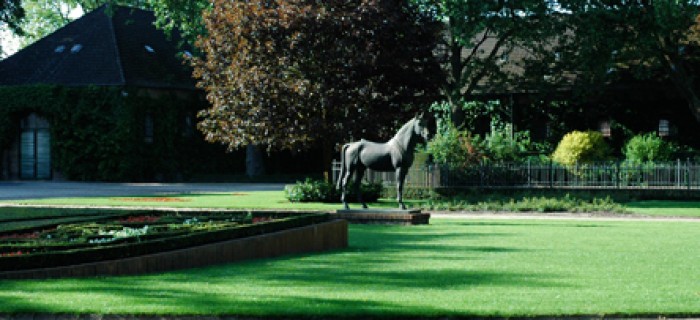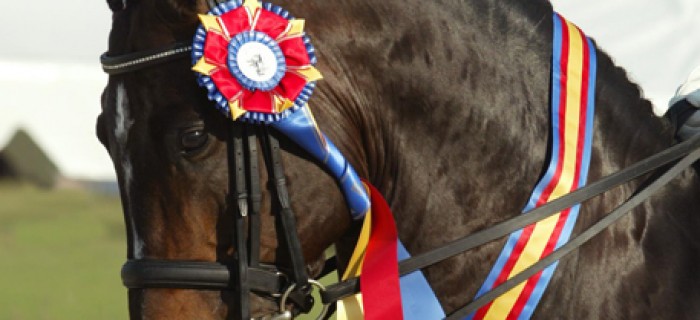1. Precondition for the development of the counter canter
In a first step, we have to ask which preconditions have to be fulfilled to start developing the counter canter, in other words: when is your horse ready to learn the counter canter?
The canter is a swinging movement with three beats and six phases of move-ment including a moment of suspension. The six phases of movement are:
• One leg support
• Three leg support
• Diagonal two leg support
• Three leg support
• One leg support
• Moment of suspension
In the true canter the inner leg pair steps more forward then the outside leg pair.
In the counter canter the leg pair toward the arena wall steps more forward and the horse is bent slightly towards the arena wall, thus making the arena wall the inside (remember: inside is always where your horse is bent toward – looking at). Both leg pairs stay on the lead and the corners of the arena can be slightly rounded.
The counter canter is a collecting movement and it helps straightening your horse. Apart from that, a further benefit of the counter canter is that it makes your horse sensitive to the diagonal aid of the rider and makes him accept the canter aids both in the true canter and the counter canter. Many riders tend to put their horse in canter with the rider’s outside leg – a mistake that will come back to you when training the counter canter. Your horse will first not under-stand what you want from him when you give the – correct – aid for the counter canter because it is too similar with the formerly wrong given aid for the true canter. Thus the counter canter helps you to climb the last two steps of the German training scale: Straightness and Collection and makes you come to the overall goal of throughness.
a. Precondition for the horse
Precondition for the horse is that the horse has achieved the first levels of collection – otherwise it will not be able to make it through the corner in the counter canter. It has to be securely on your aids in the true canter and be able to show a couple of collected strides in the true canter. Overstraining the horse in the development can lead to uncertainty. The horse starts to get hot or changes the canter into a cross-canter – in the end loosing the contact to its rider completely. This is not the way we want to train our horses – we want the both parties – horse and rider – enjoy their develop-ment through the levels.
b. Precondition for the rider
Precondition for the rider is a good and balanced seat. You must be able to sit with a calm upper body and an elastic hip into the movement of your horse. Remember to pull your inner hip slightly more forward (Do you remember which is the inner side in the counter canter?) without pulling your outside shoulder back. Your shoulder is always aligned to your horse’s shoulder.
2. Aids for the counter canter
As every new movement, the counter canter has to be prepared with half halts to get your horse’s attention and make him step with his hindleg toward the centre point. This movement toward the centre point is necessary to make the horse take more weight on the hindleg thus making the start of the canter easier.
Let’s go through the half halts again: The half halt is a combination of all three aids of the rider: leg, weight, rein. The rider combines the weight aid on both sides, the forward leg aid with a keeping elastic rein weight thus “framing the horse” for a moment. A good ridden horse will step into the rein and seek the contact after receiving the forward aids of leg and weight this way “picking up” his rein aid by itself. Remember this: it is NOT kicking your horse in the belly and pulling the rein at the same moment! It is pushing the horse into the steady rein, frame him and then release the rein without ever losing the con-tact with your horse’s mouth. The half halt is ALWAYS finished with a releasing rein aid.
Half halts are the combination of all three aids the rider has and enable the rider to control the horse’s movement.
Important: The half halt is framing your horse with weight-, leg- and rein aid followed by a releasing rein aid.
For the true canter you will give the following aids:
– Half halts make your horse attentive and step more toward his centre point
– Your weight lies on the inner hip
– Your inner leg is pushing forward at your saddle girth
– The inner rein is giving the horse’s head an inward position
– The outside rein controls this inward position and prevents your horse to fall over his outside shoulder
– Your outside leg is controlling the horse’s outside leg giving him a movement toward centre point. Your outside leg is very important, because the horse’s outside hind leg can only bear the horse’s weight in the “one leg support phase” if properly moving toward the centre point. If not your horse will stop cantering and fall into trot.
– When you feel your horse starts to canter your inner rein releases a bit in order to give your horse the freedom to jump into the releasing inner rein without ever losing the contact to your horse’s mouth.
The weight and leg aids control the movement in the canter. The correct posi-tion of both rider’s legs is responsible fort he right lead. Every stride is ridden like starting the new canter. The rider’s calm hand seek constant contact to the horse’s mouth. With half halts the rider controls the horse’s hindlegs and makes it push toward ist centre point.
If we now connect all the dots we can see: in the counter canter the leg pair toward the arena wall is the one that pushes more forward meaning: the leg pair on the side of the arena wall is the inside lead. The aids for the counter canter are identical as for the true canter considering that the arena wall is ac-tually your inner lead.
Be aware that your inner rein has to be very sensitive in order to allow the horse’s hindleg to move toward the centre point. In Germany we call this: “The rider’s inside hand has to let the stride free”.
3. Exercises for the development of the counter canter
Precondition is –as mentioned above already – that your horse is able to show a balanced true canter with all the movements of the level A. This includes ex-act riding of the corner. Moreover the horse has to be able to show a few strides of collected true canter. Check this with the following exercise:
You ride collected true canter in a half arena (20×20 m) with exactly ridden corners (A-B-E-A). In a second step you ride collected true canter in a quarter arena (A-B-X-A) thus controlling if the horse is really able to canter through the corners immediately followed be a straight line. Remember to really ask for deep ridden corners. Change the lead with a canter-walk-canter transition. Train on the other lead.
After this check you start cantering in the whole arena in a collected true can-ter. Along the long side of the arena you start to ride a simple sinous line that has its turning point on B or E. Thus the horse canters in a counter canter on the second half of your serpentine. If the horse is comfortable with this exer-cise you start riding the bow of this serpentine bigger and bigger, this way reaching X as turning point, later reaching the opposite wall (B or E) as the turning point.
In the next exercise the degree difficulty is increases. You start cantering true canter and change the lead by using the short diagonal from for example K to B or F to E without changing the canter. It is important to stop the counter can-ter before coming to the corner of the short side, after a while you include the first corner than the second corner into this exercise. Change into the true can-ter with riding over the long diagonal (K-X-M or F-X-H) making the strides longer. Remember: you are riding “true canter on the wrong lead“, do not change your position, your correct seat is very important in this moment. Your inside rein keeps the inside position of your horse’s neck, your inner leg de-mands every stride and your outside rein prevents that your horse falls over his outside shoulder and your outside leg controls the horse’s outside hind leg. Very important: if your horse does a flying change in this moment, never pun-ish him for that! You will need the flying change later in his development and if he learns that he gets punished for the flying change he will stop offering this movement. If your horse does a flying change you have to go back in the ex-ercise starting with the serpentine again.
More exercises are the half circle out of the corner and changing the circle without changing the canter and riding a circle in the counter canter with two 10 m circles in true canter.
During all exercises it is important to ride true canter with extensions in the true canter down the long side of the wall and work the trot as well to get your horse’s attention.
The last exercise should be the starting of the counter canter – first without riding trough the corner than including the corners into your work.
Enjoy riding! Adriane
Share
